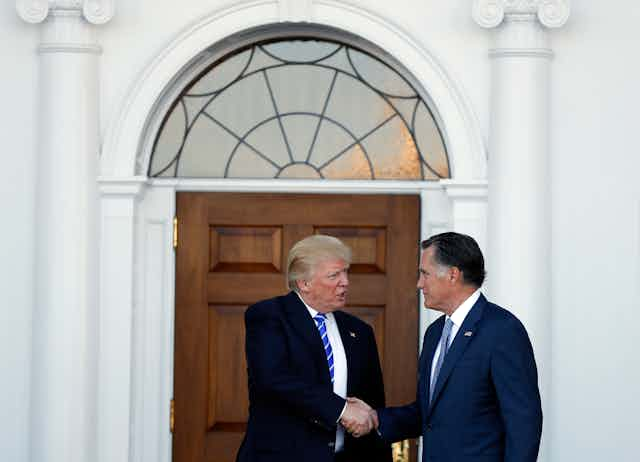“Partnership, not conflict,” were the words spoken by President-elect Donald Trump during his acceptance speech. That collaborative approach is what my scholarship on good governance shows is required for effective public administration.
That is also what effective and sustainable leadership demands of the Republican Party, which is now in a position to govern with a majority in both the House and Senate. Some of Trump’s recent actions, such as the selection of Stephen Bannon for White House strategist and his urge to respond to critics on Twitter, have continued to elicit concern among his detractors. Nevertheless, he has shown signs that he’s willing to work out differences by mending fences with his most vocal critics such as Mitt Romney and Nikki Haley.
Perhaps the president-elect can create the newly structured Republican Party that GOP faithfuls hoped for, but were not able to achieve in the last two election cycles. Perhaps these efforts signal a more collaborative framework at the national level of governance in a country that has been divided by political rhetoric and administrative stalemate for well over a decade.
Could the next four years of Trump presidency be just what the doctor ordered for the GOP and a divided country?
Shock to the system
Interest-based negotiations within Republican ranks, as well as between Republicans and Democrats, may follow the initial shock to status quo. From my experience as a mayor and council member, and a professor at the Bedrosian Center on Governance, I have learned successful governance is all about the quest for the win-win.
This strategy focuses on the integration of needs, desires, concerns and fears that are important to each side. Take for example, the governance model of the Lakewood Plan in Lakewood, California – a city of just over 81,000 people outside of Los Angeles. The motive behind the plan, which was put forth in 1954, was to retain local control over local services. Residents wanted to eliminate duplication and rely on more efficient and cost-effective government service providers.
Public and private organizations collaborated to solve public policy and administration problems based on interests. This manifested in a number of ways: for example, a trash hauler in the private sector collecting municipal waste; a county fire department providing fire service to smaller cities; private lawyers acting as city attorneys; private arborists trimming city trees; citizens using a smartphone application to report a dangerous condition on the road.
This innovative plan became the model for hundreds of communities in California to deliver municipal services through collaboration.

During this unusual election cycle, the American people similarly asked their leaders to search for common interests and common good among urban and rural interests. Working-class women in blue states gave Trump double-digit margins. This imbalance in the blue states pierced the Democratic “blue wall” at its most vulnerable place. According to reporting by The Atlantic, Democratic voters in blue states like Ohio, Pennsylvania and Indiana simply voted for “self-preservation.” They voted to preserve what is left of their jobs. They voted to bring back lost jobs to preserve their local communities.
Reconciling urban politics with those of rural America is not a new problem, but the Trump administration needs to focus on the integration of rural needs and urban America.
In the postmortem of this highly contested and polarized elections, President-elect Trump and the GOP alone can decide if they will become irrelevant through ideological competition or succeed through collaboration.
These Rust Belt voters expect to be “great again.” But four years isn’t much time to change the fate of neglected Democrats and Republicans living in the Rust Belt. If the city-educated elites and urban global politics remain the priority, I believe the Rust Belt will vote for change again in 2018 and 2020 in larger numbers.
President-elect Trump appears to be hinting at this when he said in his acceptance speech:
“It’s time to pledge to every citizen of our land [urban and rural] that I will be president for all Americans, and this is so important to me.”
As an outsider, Trump is not burdened by GOP party ideology. I believe this makes him well suited to set the tone for interest-based negotiations to address both short- and long-term goals set during the campaign. A simple page out of local collaborative governance may serve this presidency and the American people.

